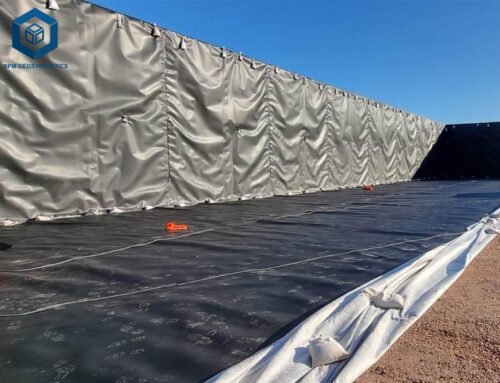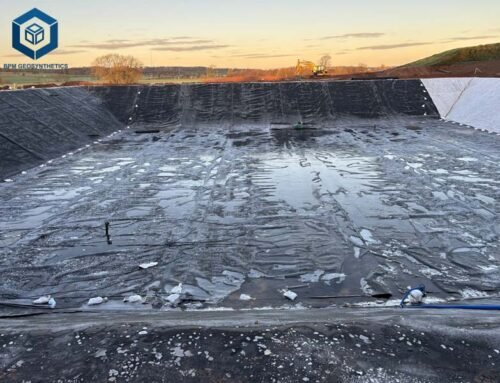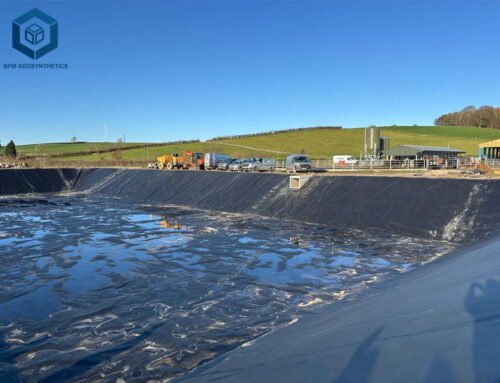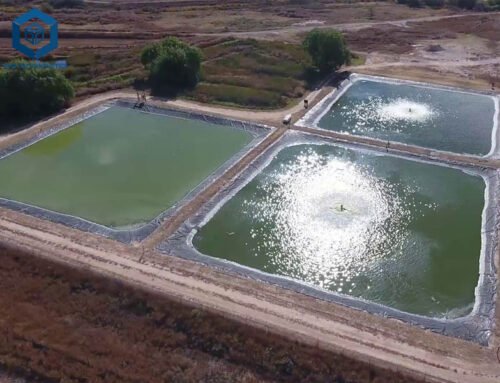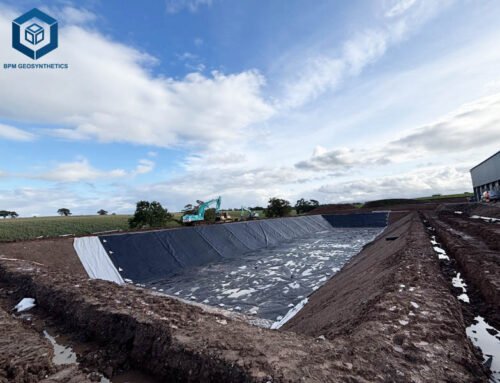HDPE Geomembrane Sheet provides an affordable and durable solution for a variety of water containment applications. It is suitable for applications where strength, tear resistance, and long life are required. Their versatility and reliability make them a popular choice for a variety of pond and water management projects in various industries and fields. Over the past decade, HDPE Geomembrane Sheet has played an important role in geotechnical engineering.
Our BPM brand geomembranes have been installed in various engineering projects around the world. With 20 years of geotechnical engineering experience, we provide our customers with quality HDPE Geomembrane Sheet products and professional geomembrane installation experience.
Next, this article will start from the definition, advantages, and application of geomembrane in various projects, explores the benefits, and environmental impacts of each application.
1. What is HDPE Geomembrane Sheet?
HDPE Geomembrane Sheet is a type of impermeable membrane made from High-Density Polyethylene (HDPE). It is widely used in environmental, geotechnical, and hydraulic applications as a barrier to control fluids or gases.
Key Features of HDPE Geomembrane Sheets:
(1) Material: Made from high-density polyethylene resin, which provides excellent chemical resistance, durability, and UV stability.
(2)Thickness: Typically ranges from 0.5mm to 3.0mm, depending on the application.
(3)Strength: High tensile strength and puncture resistance, making it suitable for heavy-duty applications.
(4)Impermeability: Extremely low permeability, preventing leakage of liquids and gases.
(5)Chemical Resistance: Resistant to acids, alkalis, oils, and other harsh chemicals.
(6)UV & Weather Resistance: Contains carbon black or other additives to enhance UV resistance for long-term outdoor use.
(7)Flexibility: Can withstand differential settlement and ground movement without cracking.
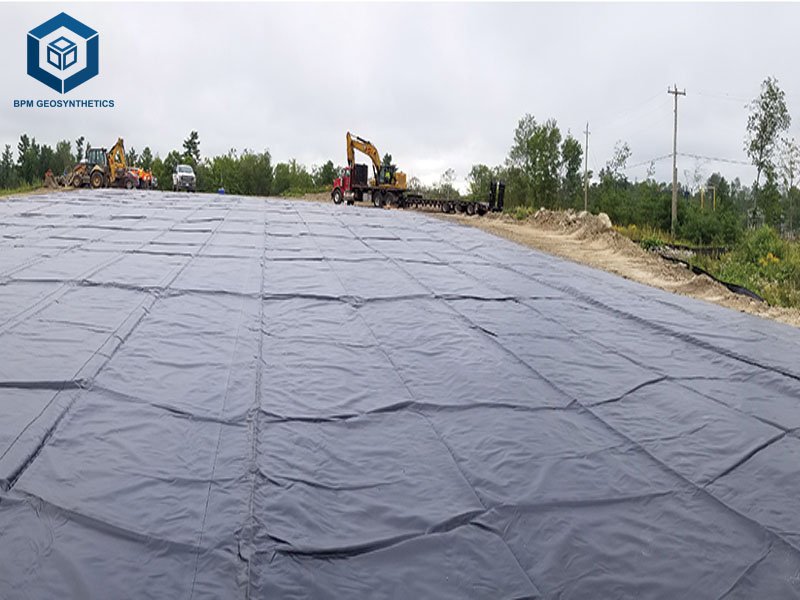

2. Advantages of HDPE Geomembrane Sheet
HDPE Geomembrane Sheet have excellent resistance to puncture, tear and dimensional change. These liners provide long-term performance and reliable protection against leaks. In addition, they are resistant to UV radiation, chemicals and environmental stress, suitable for a variety of climate and water conditions.The benefits of HDPE Geomembrane Sheet include enhanced strength, durability,tear resistance, puncture resistance, stability, versatility, affordability, reliable containment, easy installation,and environmental friendliness, making it a top choice for a variety of ponds and water containment projects.
2.1 HDPE Geomembrane Sheet – Enhanced strength
2.2 HDPE Geomembrane Sheet – Enhanced durability
2.3 HDPE Geomembrane Sheet – Improve tear resistance
2.4 HDPE Geomembrane Sheet – Better puncture resistance
2.5 HDPE Geomembrane Sheet – Stability and structural integrity
2.6 HDPE Geomembrane Sheet – Versatility
2.7 HDPE Geomembrane Sheet – Affordable
2.8 HDPE Geomembrane Sheet – Reliable accommodation
2.9 HDPE Geomembrane Sheet – Easy installation
2.10 HDPE Geomembrane Sheet – Environmental friendly
3. Application of HDPE Geomembrane Sheet
HDPE Geomembrane Sheet has a wide range of applications due to its excellent waterproofing, durability, and chemical resistance properties. Here are some key applications:
3.1 Large ponds and lakes
3.2 Aquaculture and fisheries
3.3 Wastewater treatment pool
Wastewater treatment facilities rely heavily on effective containment systems to protect environmental integrity, and HDPE Geomembrane sheet plays a critical role here as a core component of reinforced polyethylene pond liners. First, these liners create an impermeable barrier that directly stops wastewater leakage— a key step in avoiding harmful seepage into underlying soil layers. Without this barrier, contaminants like heavy metals or organic pollutants could easily infiltrate the ground, but the durable HDPE Geomembrane sheet blocks such risks entirely. Additionally, this liner design not only safeguards surrounding soil quality but also preserves groundwater reserves, which are vital for both ecosystems and human use. By integrating HDPE Geomembrane sheet, operators ensure their treatment ponds meet environmental standards while maintaining long-term operational reliability.
3.4 Decorative ponds and water features
Beyond industrial uses, HDPE Geomembrane sheet also shines in decorative and gardening contexts, where it elevates the functionality of water-focused projects. For starters, homeowners and landscapers often use it to line decorative ponds—its strong, tear-resistant structure ensures the water stays contained, even as plants grow or small wildlife interacts with the pond. Then, for custom water features like fountains or small cascades, this geomembrane sheet provides a reliable base; it adapts to different shapes without compromising durability, so the feature retains its design and holds water consistently. Additionally, in gardening projects such as rain gardens or raised water beds, the HDPE material prevents soil from mixing with water reserves while resisting rot or degradation. All in all, it turns simple gardening ideas into long-lasting, low-maintenance water features.
3.5 Industrial Applications
Industries across sectors rely on robust containment solutions, and HDPE Geomembrane sheet forms the backbone of reinforced polyethylene pond liners for this exact need. First, factories use these liners to store harsh chemicals—their impermeable HDPE core stops leaks that could damage equipment or harm workers. Then, for holding large volumes of industrial liquids, the sheet’s durability handles constant pressure without cracking. Additionally, when managing industrial wastewater, the liner traps contaminants securely, preventing them from seeping into work areas. By integrating HDPE Geomembrane sheet, businesses ensure safe, compliant storage that supports smooth daily operations.
3.6 Agricultural reservoir
Farmers often turn to reinforced liners with HDPE Geomembrane sheet for agricultural reservoirs and irrigation ponds, as these liners solve key water storage challenges. First, they rely on the sheet’s impermeable design to lock in water—critical for keeping reserves intact during dry spells, ensuring crops get steady irrigation. Then, for livestock drinking water, the liner’s durability prevents soil or debris from seeping into the supply, keeping the water clean and safe for animals. Additionally, the sheet resists damage from weather or farm equipment, so the ponds stay functional season after season, supporting consistent farm operations.
3.7 Stormwater Management
Engineers and urban planners use reinforced polyethylene pond liners with HDPE Geomembrane sheet to build detention ponds in stormwater management systems. First, these liners form a tight seal that holds large volumes of stormwater runoff, stopping excess water from overwhelming drainage networks. Then, the HDPE Geomembrane sheet’s durability ensures the ponds withstand heavy rainfall and constant water pressure without leaking, which is key to preventing local flooding. Additionally, the liners maintain the ponds’ structure over time, letting them consistently slow and manage runoff, which protects nearby roads, homes, and green spaces from water damage.
3.8 Mining and landfill applications
Mining and landfill operators rely on reinforced liners with HDPE Geomembrane sheet to contain liquids, leachates, and waste materials effectively. First, in mining operations, these liners hold process liquids and prevent them from seeping into surrounding soil, shielding local ecosystems from contamination. Then, in landfills, the HDPE Geomembrane sheet acts as a barrier against leachates—toxic liquids from decomposing waste—stopping them from reaching groundwater. Additionally, the liner’s strength resists damage from heavy waste or mining debris, ensuring long-term containment. This setup not only meets environmental regulations but also adds a critical layer of protection for nearby communities and natural resources.

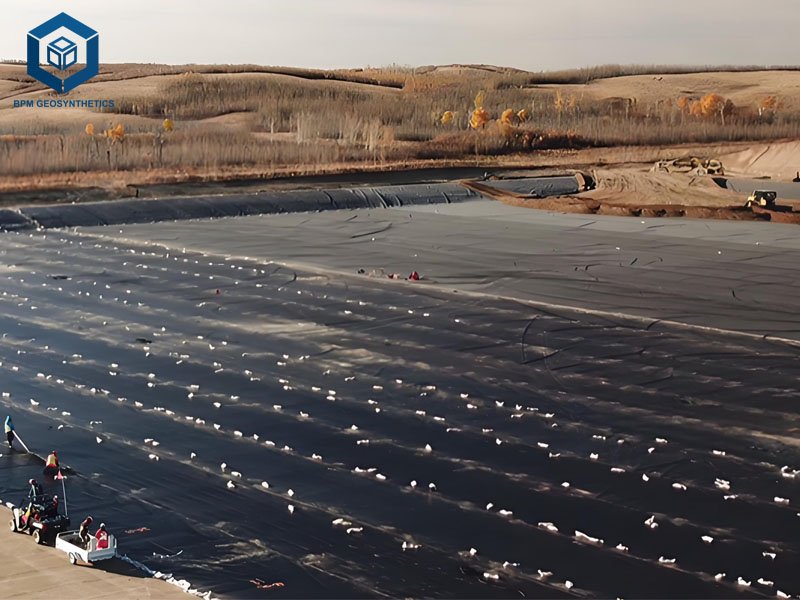
With 20 years as a geomembrane export manufacturer, BPM Geomembrane operates 3 smooth HDPE Geomembrane production lines and 1 rough-surface line. We produce HDPE Geomembrane Sheet in widths from 2m to 10m and thicknesses from 0.2mm to 3mm. Since we ship products in containers to customers, most clients request widths of 5.8m, 7m, or 8m. However, we can also make other custom widths if needed. For instance, a 3m width may cause raw material waste, so its price will likely be higher than standard widths (5.8m to 10m). If you have any questions about our products or customization, feel free to consult us.

